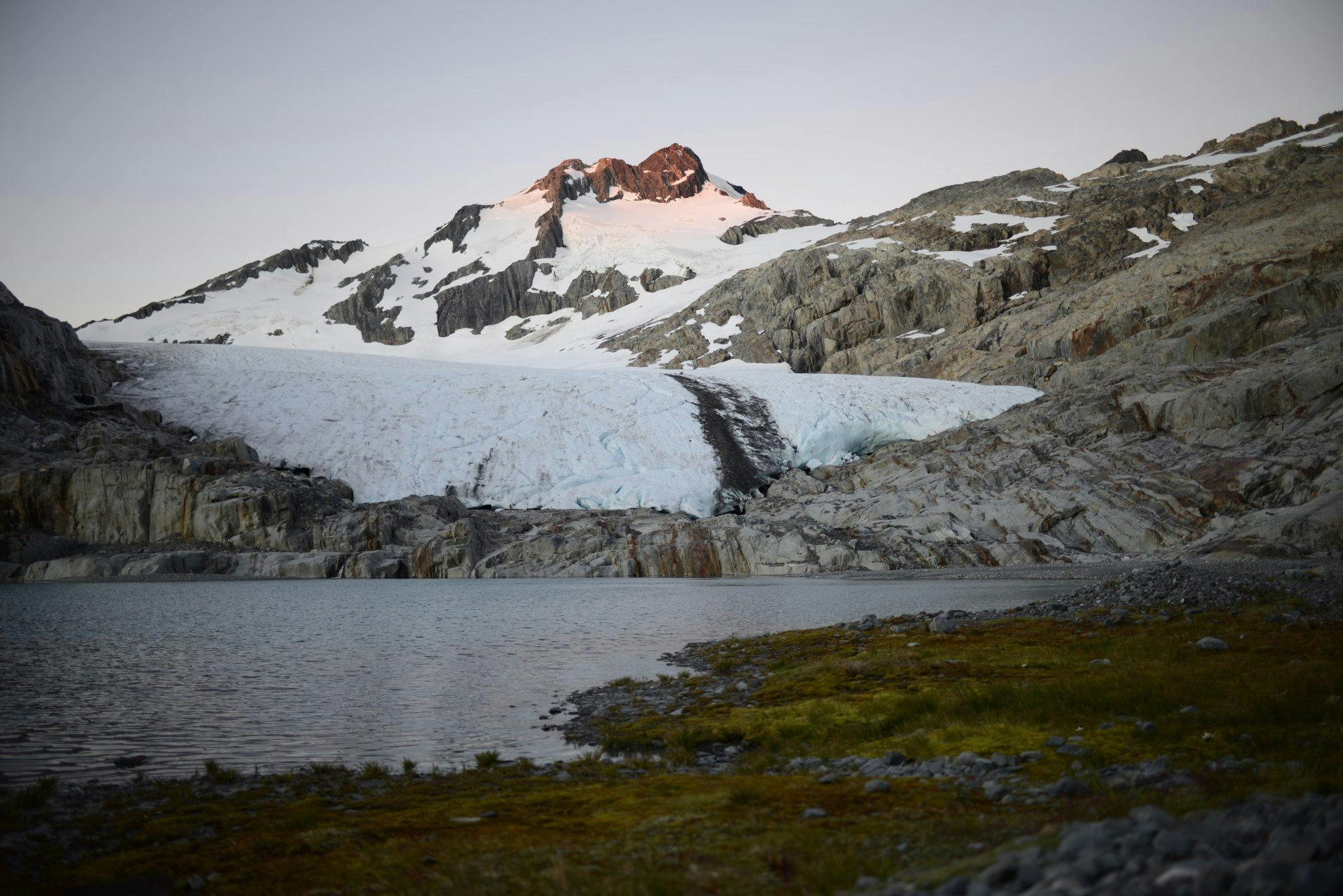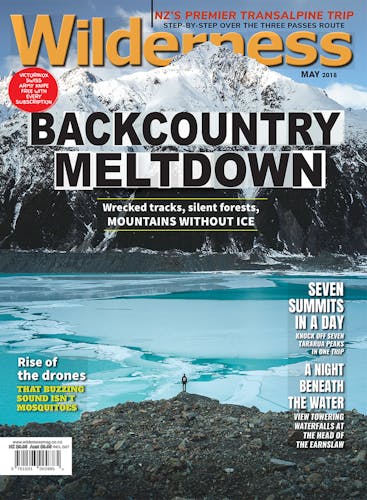Increasingly ferocious storms, rising sea levels and soaring temperatures are expected to knock out more tracks, campsites, huts and erase the alpine features which attract hundreds of thousands into the outdoors.
After ploughing through the South Pacific, Cyclone Fehi snaked its way towards the top of the South Island. It hit during a king tide. The normally sheltered bays of Abel Tasman National Park took the full force. The park’s network of picture-postcard campsites, perched just above the high-tide mark, didn’t stand a chance. Three metre high waves crashed onto some campsites, dumping up to half a metre of golden sand on four sites which had served happy campers for generations. The worst hit, Tonga Quarry Campsite, will be closed permanently.
But it didn’t stop with Fehi. In the next three weeks, the Tasman region was inundated by two days of extreme rainfall, washing out bridges and tracks and causing major slips. On February 11, 116mm fell in Nelson in 12 hours – the highest day of rainfall in February since records began in 1862. The next week, ex-tropical cyclone Gita struck – 148.4mm of rain fell on Motueka in just 14 hours. Major access roads to Abel Tasman and Kahurangi national parks were washed out, and the total clean-up bill is estimated to be up to $12 million. And it all happened just a month after the region was in the depths of a drought and park managers were considering closing tracks due to extreme fire risk.
It’s left DOC wondering whether it just got a taste of the future. Sea levels are expected to rise by between 20cm and 40cm over the next 40 years and could be up to a metre higher by 2100. Storms are also predicted to become more intense and with more frequent extremes, like droughts and floods.
“It’s a wake-up call,” says DOC Motueka operations manager Mark Townsend.
“It’s crystal ball gazing, but we have to prepare for it [climate change]. These kind of events are likely to become more and more frequent and we’ve got millions of dollars worth of infrastructure not far off sea-level.”
Townsend is responsible for managing Abel Tasman’s 17 coastal campsites and three waterfront huts, all part of the Coast Track Great Walk – the most popular multi-day walk in the country (in 2016/17 44,089 people stayed at huts or campsites on the Great Walk). After the storms of February, he is now looking for options to retreat from the most vulnerable spots.
“In the past, we’ve had plans for the next five and 10 years. But what’s clear is we need to look longer term. We are starting to look at where we can retreat to.”
At the western end of the park, Golden Bay operations manager Andrew Lamason says more storms will mean there will be some tough decisions in future. Lamason is planning to rebuild a new 700m section of the Great Walk, after part of it fell into the sea following intense rain. But while tourism draw-cards and frontcountry sites are top of the maintenance priority list, he says in the future not all infrastructure will be able to be maintained.
“For 20 years they’ve been telling us the weather’s going to change,” Lamason says. “Well, it’s changing. As a nation, we need to get our head around what the future will be. If this is the new normal, we need to think about what’s going to be repaired and what we are going to walk away from – there’s only so much money. We can’t carry on repairing things that are going to be broken again.
“The reality may be that there will be fewer tracks and less maintenance.”
Some of those decisions are already being made. The Kaituna Track at the western end of the bay, which runs over the Burnett Range to Whanganui Inlet on the West Coast, was severely damaged during Gita – almost every bridge on the nine-hour track was damaged.
“It’s a really lovely track, but not many people walk it,” says Lamason. “What we are considering is degrading it to a route. There will still be a track, but we would take the structures out of it.”
It’s an issue that is likely to play out on conservation land around the country. Federated Mountain Clubs (FMC) president Peter Wilson says trampers are going to have to accept more tracks will close, or volunteers will be needed to help reopen them.
“We will lose more huts and tracks each year,” Wilson says. “Even if DOC’s budget doubled, it won’t be able to fix them all.
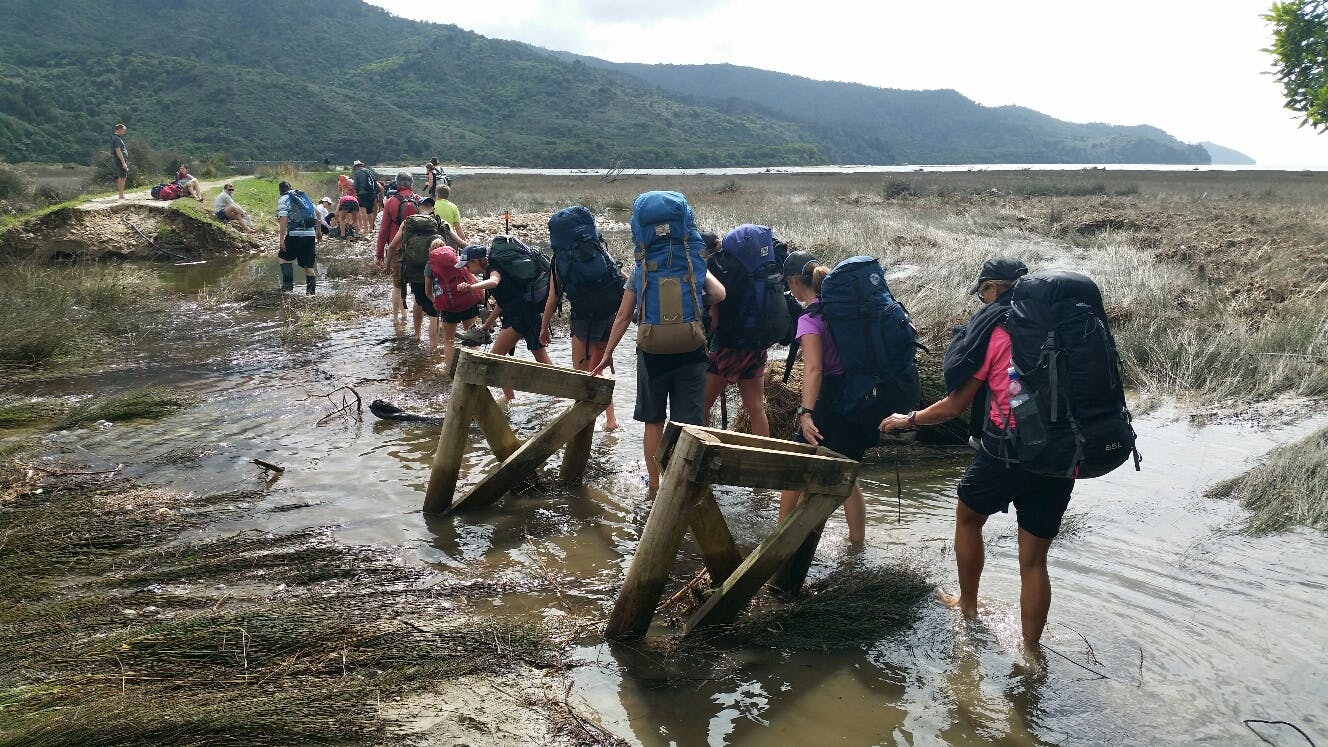
Tracks, bridges and campsites in Abel Tasman National Park were flooded in storms earlier this year
“But if people want to keep tracks like Kaituna open, they may have to put their own time in. But with more storms, it’s going to get harder.”
Wilson says the bigger issue will be merely maintaining the main access points to conservation land. Graham Valley Road and Cobb Dam Road – the most popular roads to Kahurangi National Park – have been closed since February after a bridge was washed out and a large slip occurred. The cost to repair them is expected to run into hundreds of thousands of dollars.
“Just maintaining basic access is going to cost more and more,” Wilson says. “But this is the cost of climate change. It’s the cost of us running around in vehicles for the last 100 years.”
At a national scale, it is something DOC is starting to look at. Darryl Lew, the department’s director of operations and planning, is developing a report, working with NIWA to assess how a changing climate will impact DOC’s infrastructure. Lew wouldn’t be drawn on what DOC’s approach will be to this challenge until the report is finalised in the next few months.
In the mountains, the warming climate has already dealt a blow to infrastructure and access. In Aoraki/Mt Cook National Park alone, six huts have been closed or removed in the past decade due to damage from rockfall, or loss of access due to retreating glaciers. Climbers say the Alps have also become more dangerous, with more rockfall and more risky and challenging access as ice retreats.
Dave McKinley has been climbing in the Southern Alps for 30 years and says the changes have been dramatic. “This year alone I’ve observed fresh rockfall off the Minarets, Mt Haidinger, and lots of smaller ones throughout the park. Some places are also becoming heavily crevassed, which is making access really complex.”
A survey of New Zealand Alpine Club members also found that access was becoming more difficult and more dangerous as glaciers receded.
Other impacts are harder to quantify. Melting glaciers mean losing some of the most dramatic features that attract people into the outdoors. It can be an emotional loss, as much as a physical one. But McKinley is philosophical about the changing landscape.
“Sometimes there’s a sense of loss and sometimes there’s a sense of wonder,” he says. “There are features that I look at and go, ‘well that’s not what I remember’. But that’s part of being in the outdoor world. It’s a dynamic environment. We are just lucky we still have a massive amount of snow and ice. But it is changing rapidly.”
University of Canterbury glaciologist and senior geography lecturer Dr Heather Purdie first visited Aoraki/Mt Cook National Park when she was seven and says there have been dramatic changes in a single generation.
“My dad recalls taking a bus down the Ball Hut road and climbing down a small ladder onto Tasman Glacier,” she says. “Now the car park is at the head of a 7km long lake and you have to climb down a 200m moraine wall to get onto the ice.
“You wonder what the mountains will look like in another 20 or 30 years. Even in 10 years time, I wonder how much more complicated access will be.”
Purdie has monitored the Rolleston Glacier near Arthur’s Pass since 2010. Out of more than 3100 glaciers in New Zealand, the Rolleston Glacier is one of only two that are comprehensively monitored to see how much their mass changes year to year (the other is Brewster Glacier in Mt Aspiring National Park). Each year, a team of scientists heads to the glacier at the end of winter to measure how much snow has fallen, and again at the end of summer to determine whether there has been a net accumulation or loss of ice.
“We are seeing more crevasses, more rockfall and less snow left at the end of the season,” Purdie says. “It’s getting a bit thinner and shorter and bergschrunds are getting bigger [where the glacier detaches from the headwall].”
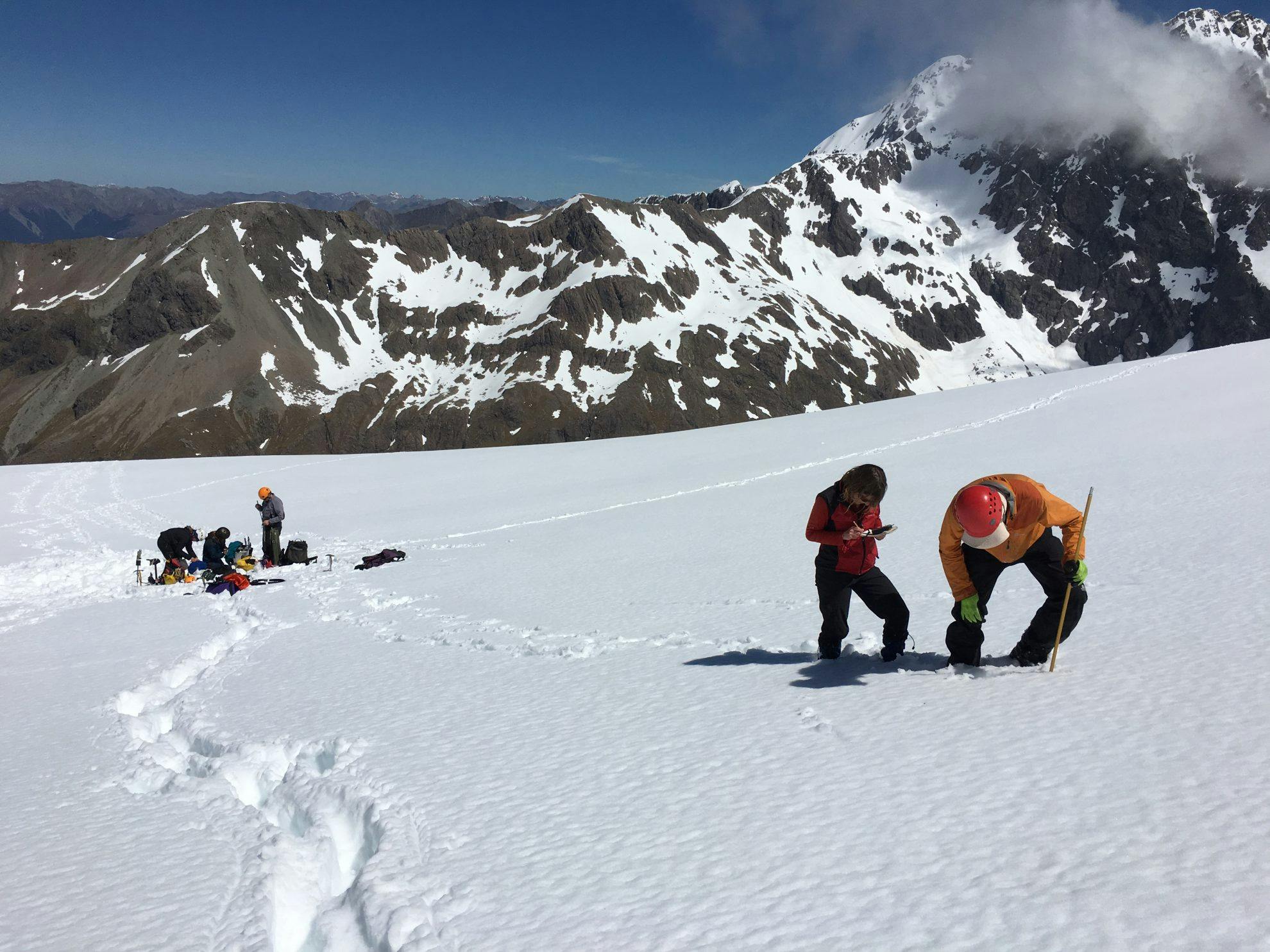
Researchers from the University of Canterbury survey the Rolleston Glacier at the end of winter and summer to determine whether it has gained or lost mass. Photo: Rasool Porhemmat
The past summer was the hottest on record – two degrees warmer than normal – and more snow and ice has melted than has ever been recorded. Since 1977, there has been an aerial survey of 50 glaciers in the Alps, completed during March each year, when the snowpack is usually at its lowest. Over that time, it has recorded a 24 per cent reduction in ice volume in the Alps.
Victoria University glaciologist Dr Brian Anderson was on the latest survey and says it was shocking.
“It’s by far the worst season that’s been seen during the survey period,” Anderson says. “A glacier needs to have two-thirds of snow cover at the end of summer to remain stable. This year, 30 of them didn’t have any snow left at all.
“It was quite sobering. I’d visited a few glaciers over the summer and it wasn’t looking good, but to see it over the entire Southern Alps was shocking.”
Some glaciers are becoming so small they may be dropped from the survey altogether.
“What looked like good glaciers to measure 40 years ago, in some cases there’s just not much left. The Jalf Glacier near Franz Josef is one example – it hasn’t had snow accumulation for years and years. It’s a dying glacier, sitting there melting out.”
So what does the future hold for these iconic features? Anderson has been developing models to answer that question and says by 2050, about a third of the ice in the Alps could be gone. The 2km-long Brewster Glacier (which he monitors with colleagues from Otago and Victoria universities) is expected to retreat by half a kilometre by 2060.
But longer term, he says the future is up to us – the amount of greenhouse gases that are pumped into the atmosphere make a marked difference to how much ice will be lost. If warming is restricted to two degrees by 2100 – the goal of the Paris climate agreement – the Alps are expected to lose 32 per cent of their ice.
“There are uncertainties in the climate predictions and in the glacier modelling, but the central prediction is that the Fox Glacier would retreat to around Chancellor Hut and the Franz Josef Glacier would retreat to near Almer Hut, near the valley head,” Anderson says.
But under a high-change scenario – where nothing is done to curb global emissions and population growth is high – the temperature could rise by four degrees. Anderson’s modelling suggests that would mean losing three-quarters of the ice in the Alps, and Fox and Franz Josef glaciers would completely retreat from the valleys.
“There wouldn’t be much left, just a few little glaciers around those headwalls – nothing that’s recognisable,” says Anderson. “It would be a totally different landscape.”
In Aoraki/Mt Cook National Park, the Tasman Glacier would disconnect from the glacier head, and there would just be a debris-covered tongue left in the valley.
“These are really big changes and really big choices.”
But Anderson says everyone can contribute to what that future will be. He points to a recent paper that tries to quantify how much driving a vehicle contributes to glacier melting.
“The research found that for every 500m you drive in your car, you create enough emissions to melt 1kg of glacier ice.”
Small changes can also make a positive difference. Anderson offsets his emissions from driving by buying carbon credits from a Southland rainforest, essentially paying for trees to be protected to absorb the greenhouse gases he produces.
“For each trip, the cost of the credits is cheaper than buying a cup of coffee. I think it’s something that trampers need to think about. We have to aim for a zero-carbon economy in the next few decades.”
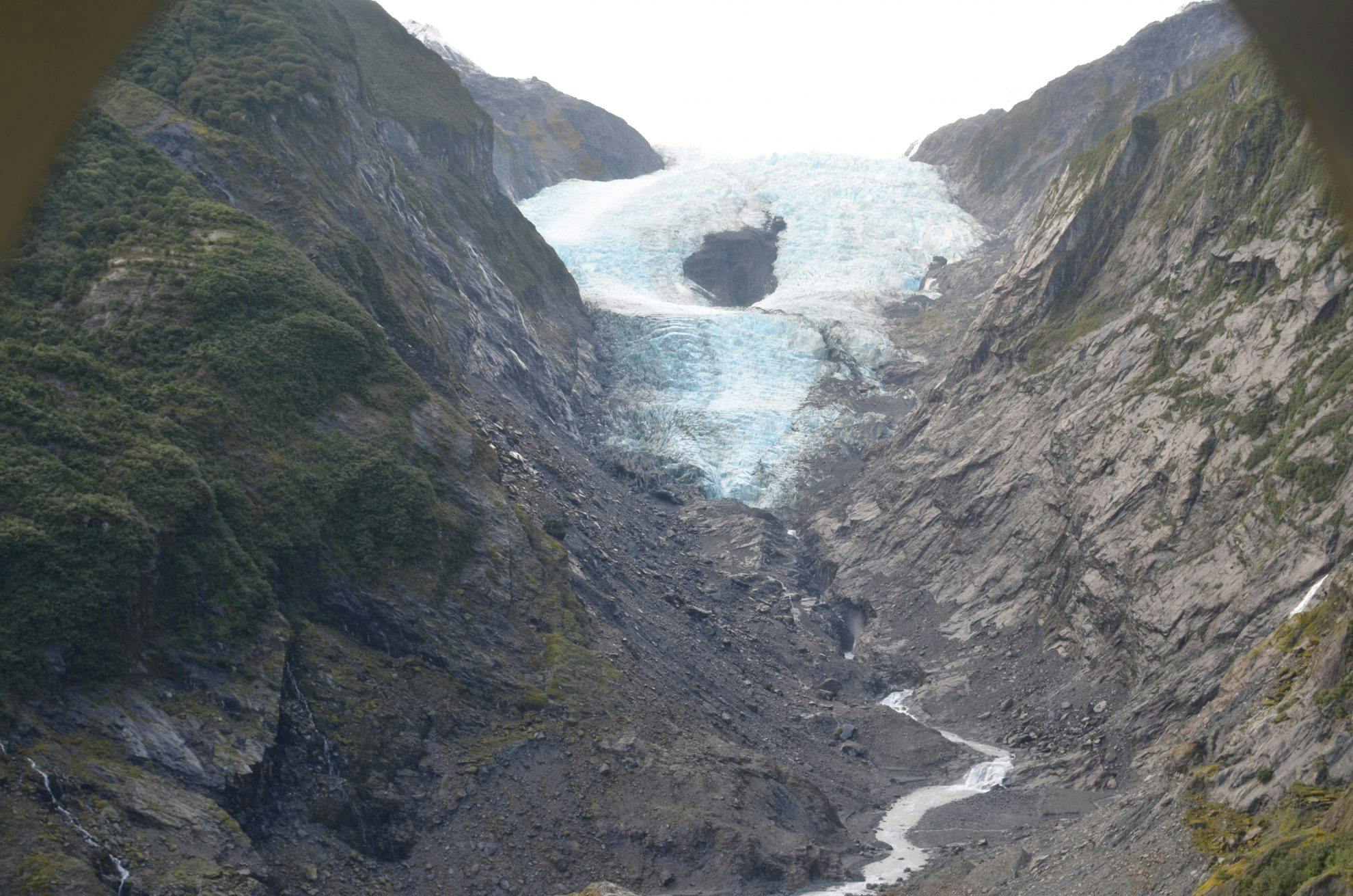
Franz Josef Glacier has retreated dramatically in recent years
Peter Wilson says it’s also something FMC will investigate later this year.
“Trampers tend to drive when they go for a trip. I’d like to look into the carbon credit schemes available so our members can make informed decisions to help reduce their carbon footprint.”
Below the treeline, big changes are also expected. Landcare Research invasive weeds, pests and diseases research leader Dr Andrea Byrom says a more variable climate could lead to an increase in the number of pests, as mast years may become more frequent. A beech mast is a year when beech trees flower and seed. The seeds are eaten by mice and rats, which leads to a boom in predator numbers. Byrom says previous mast seasons have lead to localised extinctions and will have a huge impact on the future of native species.
“The difference in temperature from one summer to the next is the major driver of a mast year,” Byrom says. “Climate models are predicting greater variability in temperature and rainfall and the higher the variability, the greater the response in flowering and seeding of beech.”
Monitoring has already found masts have increased in frequency – although it is not yet clear whether that is an anomaly, or a sign of the changing climate.
“In the 1960s, the trees were masting every four to five years,” says Byrom. “In the 1990s and 2000s that changed to be every three years and in some cases every two years. Based on that kind of trajectory, they seem to be increasing, but we really need long-term data to know.”
Byrom says this raises the question of how to plan and budget for these events. She says it will likely mean more 1080 drops – the current $21 million Battle for our Birds 1080 programme is in response to the recent spate of mast seasons.
“At the moment, aerial distribution of 1080 is the most effective means of controlling mice and rats and stoats during megamast events,” she says.
But more 1080 comes with a price tag. Byrom says one way to prepare for that would be to put aside a contingency fund.
“It’s difficult to budget for infrequent and unpredictable events that may or may not happen in the future. We need a contingency put away. For earthquakes, we have the Earthquake Commission, which is like an insurance levy on property owners. I think a similar scheme should be looked at to fund predator control following mast years so we can respond to these events in future.”
Ironically, a DOC report into how climate change will impact biodiversity found that methods used to combat climate change could have the biggest short-term impact on native species. More exotic forests are expected to be planted to absorb carbon, but that increases the risk of wilding pines and associated habitat loss. More variable rainfall and higher temperatures are also expected to mean more hydro dams for electricity and irrigation, flooding further areas.
More broadly, the report predicted problems with invasive species would get worse, as the range of rats, wasps and hedgehogs is expected to increase as temperatures rise. Weeds, like wilding pines, are also expected to move into alpine areas, while the increase in fire risk would also impact ecosystems. Kauri forests in Northland could come under stress as more droughts hit the region.
Looking to the future, there is a lot of uncertainty about what can be expected. What is certain is that major changes are coming and how we respond will make a massive difference to what happens down the track. Whether, on tramping trips in decades to come, the mountains will be capped with glaciers, or bare rock, and whether the tracks and roads to reach these places will be there at all, is up to us.





